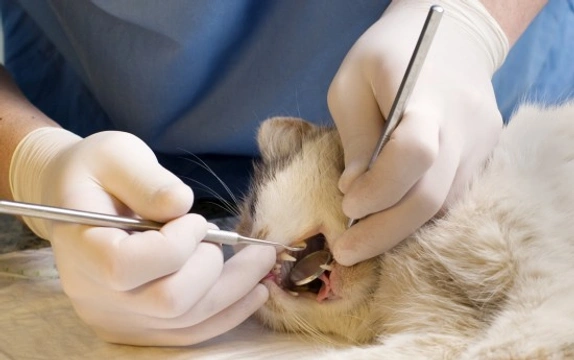
What happens during a veterinary dental procedure?
Vets and veterinary nurses work hard to promote good oral hygiene in pets such as dogs and cats, and yet few people really make a concerted effort to take care of their pet’s teeth unless something goes wrong! This means that veterinary surgeons often have to perform specialist dental procedures on pets such as dogs and cats, and after spay and neuter surgeries, dental procedures are probably the most commonly undertaken routine surgery dealt with in your average veterinary practice.
When many pet owners think of a veterinary dental procedure, they imagine the vet or a dental nurse simply brushing the pet’s teeth, and when you take this viewpoint, it can be hard to understand why dental procedures are potentially expensive, and require full sedation to achieve.
However, when you bear in mind that human dentists train for five years before they are allowed to practice, and undertake a whole range of surgical and invasive procedures that may need an anaesthetic just on people, things come into perspective rather more!
If your vet has suggested that your pet would benefit from a clinical dental procedure, they will talk you through what is involved in this, and the associated costs beforehand. It is a bad idea to overlook dental surgeries as an elective procedure or an unnecessary cost, as getting your pet’s teeth sorted out properly can greatly improve their quality of life, and even potentially extend it!
In this article, we will look in more detail at what happens as part of a veterinary dental procedure, and why such a procedure might benefit your own cat or dog. Read on to learn more!
Dental check ups
When your pet goes along to the vet for their annual boosters, your vet should also give them a thorough check over and have a good look at the state of your pet’s teeth! Some developing dental problems in cats or dogs can be reversed or nipped in the bud by a combination of feeding a special dental diet, tooth cleaning at home and various other simple treatments, but in some cases, your vet may feel that your pet needs to be checked in for a full dental cleaning procedure and check-up, in order to correct and deal with any problems.
This may be the case if your pet has lots of plaque and tartar on their teeth, bad breath, sores or abscesses, and any rotting, broken or dead teeth within their mouths.
Why sedation?
If your vision of a veterinary dental procedure simply involves you vet putting a toothbrush into your pet’s mouth, it is easy to see why the fact that the procedure needs to be done under sedation is a common cause for confusion!
However, even if your cat or dog would stay still while someone thoroughly brushes their teeth (and many will not) there is much more to a dental procedure than this- after all, your own dentist cannot correct rotting teeth, abscesses or the build-up of plaque and tartar just by brushing your teeth either!
In order to gain full access to every part of your pet’s mouth safely and without distressing your pet, your vet will need to perform the procedure with your pet anaesthetised, and from start to finish a dental procedure can take anything from half an hour up to a couple of hours, or potentially even longer.
A standard dental treatment
As a preventative treatment or to address simple issues such as a little plaque or tartar but no other major issues, your vet will anaesthetise your pet and intubate them to allow them to remain unconscious while still providing access to the whole of the mouth.
Your vet will have a special dental procedure surgery kit that contains items such as scrapers, picks and forceps, as well as a substance called prophy paste, which is used to clean debris from the teeth, polish them and strengthen the enamel.
A standard dental surgery of this type will remove the build-up of plaque and tartar, clean the gum line, and allow your vet to get a through look at every part of your pet’s mouth and teeth and identify any potential problems in the making. The teeth will then be thoroughly cleaned and polished to remove bacteria, and ensure that your pet’s breath is fresh and sweet!
Other services
A standard dental procedure allows your vet to really get a clear look at your pet’s teeth, and spot any major problems such as loose or rotting teeth, abscesses, growths and other potentially complex problems.
This means that as part of the procedure, your vet may need to perform extractions, lance abscesses and possibly carry out a whole range of other things too to restore your pet’s teeth to good health. Dental extractions in cats and dogs can be complex and challenging, as the teeth are very deeply rooted, and may require a reasonable amount of effort to remove!
Many veterinary surgeons charge a price per extracted tooth on top of the fee for the standard dental, as they will not be able to give a firm estimate of cost until they have seen how many teeth need to go, or how much effort will be required to sort out your pet’s mouth!
In some cases, severe or complex dental issues will require the services of a specialist veterinary dentist, as much like human dentistry, some challenges are outside of the realms of what can be expected within general practice.
If your own vet decides that this is the best solution for your own pet, they will be able to explain this to you in detail after they have assessed the situation properly with their own dental procedure.



